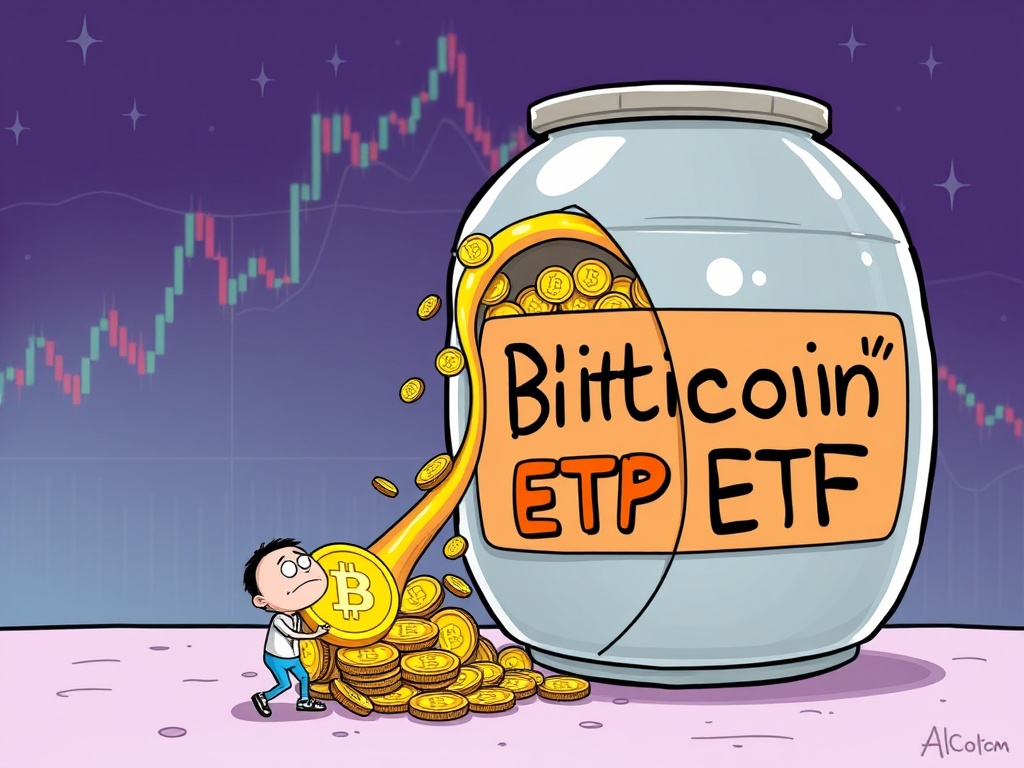BitcoinWorld

US Spot Bitcoin ETF Outflows: A Staggering $812 Million Exodus Raises Concerning Questions
The world of cryptocurrency is rarely dull, and August 1 proved to be a particularly eventful day for investors watching the U.S. spot Bitcoin ETF market. On this single day, these highly anticipated investment vehicles witnessed a combined net outflow of a staggering $812.27 million. This figure marks the highest daily net outflow observed over the past five months, sending ripples through the digital asset community. Understanding these significant US spot Bitcoin ETF outflows is crucial for anyone navigating the volatile yet promising landscape of digital finance.
US Spot Bitcoin ETF Outflows Reach Record Highs: A Detailed Look
The sheer scale of the US spot Bitcoin ETF outflows on August 1 caught many by surprise. According to data shared by Trader T on X, the total net outflow of $812.27 million represents a substantial movement of capital out of these funds. This event underscores the dynamic nature of institutional and retail interest in Bitcoin exposure through regulated investment products.
The outflows were not evenly distributed, with some funds experiencing far greater reductions in their holdings. This highlights varying investor behaviors and fund-specific dynamics within the broader market.
| Spot Bitcoin ETF | Net Outflow (August 1) |
|---|---|
| Fidelity (FBTC) | $331.42 million |
| ARK Invest (ARKB) | $327.93 million |
| Grayscale (GBTC) | $66.79 million |
| Bitwise (BITB) | $38.27 million |
| Grayscale Mini BTC | $33.60 million |
| Franklin Templeton (EZBC) | $6.57 million |
| Invesco (BTCO) | $5.08 million |
| BlackRock (IBIT) | $2.61 million |
Fidelity’s FBTC and ARK Invest’s ARKB accounted for the majority of the outflows, signaling substantial position adjustments. While Grayscale’s GBTC also saw outflows, its proportional impact was less given its larger asset base. Several other ETFs, including Invesco’s BTCO and BlackRock’s IBIT, also reported net outflows, though on a smaller scale. Some ETFs reported no change in their holdings.
Why Did US Spot Bitcoin ETF Outflows Occur So Suddenly?
The sudden surge in US spot Bitcoin ETF outflows prompts an important question: what factors contributed to this significant capital movement? Market analysts and observers point to several potential reasons, often a combination of macro-economic shifts and specific cryptocurrency market dynamics.
- Profit-Taking: After periods of price appreciation, some investors may choose to realize profits. ETFs provide an easy mechanism for institutional and large-scale investors to do so.
- Broader Market Correction: The cryptocurrency market is subject to cycles of correction. A general downturn in investor sentiment or a specific crypto trigger could lead to reduced exposure.
- Macroeconomic Factors: Changes in interest rates, inflation data, or geopolitical events can influence investor appetite for risk assets like Bitcoin.
- Rebalancing Strategies: Large institutional investors often rebalance their portfolios periodically to maintain a desired risk profile or align with new mandates.
- Regulatory Uncertainty: While spot Bitcoin ETFs are approved, the regulatory landscape for cryptocurrencies remains fluid. New proposals or increased scrutiny could cause temporary pullbacks.
A single day’s data, while significant, doesn’t always indicate a long-term trend. These outflows could be a one-off event driven by specific circumstances affecting a few large players, rather than a widespread loss of confidence.
The Immediate Impact of US Spot Bitcoin ETF Outflows on the Market
When significant US spot Bitcoin ETF outflows occur, the immediate impact on the broader cryptocurrency market, particularly Bitcoin’s price, can be noticeable. While direct causation is complex, a large outflow from these funds can contribute to selling pressure on Bitcoin in the underlying market.
Here’s how these outflows can influence the market:
- Increased Selling Pressure: When investors redeem shares, the ETF provider typically sells a corresponding amount of Bitcoin to meet those redemptions. This adds to the supply, potentially driving down price.
- Shift in Market Sentiment: Large outflows can be interpreted as weakening institutional interest, leading to a decline in overall market sentiment and potentially triggering further selling.
- Liquidity Concerns: Very large, sudden outflows could test liquidity in certain trading pairs or at specific price levels.
The market’s reaction is often a blend of direct selling impact and psychological impact from perceived trends. Traders and analysts closely monitor these flows as an indicator of institutional conviction.
Navigating Volatility: Insights for Investors Amidst US Spot Bitcoin ETF Outflows
For investors, understanding the implications of events like significant US spot Bitcoin ETF outflows is key to making informed decisions. Market volatility is inherent in cryptocurrency, and reacting impulsively to daily fluctuations can harm long-term goals.
Consider these insights when navigating market uncertainty:
- Maintain a Long-Term Perspective: Bitcoin’s price history shows cycles of rallies and corrections. Investors with a long-term horizon often view dips as opportunities.
- Diversification is Key: A diversified portfolio across different cryptocurrencies or traditional assets can help mitigate risk during downturns.
- Do Your Own Research (DYOR): Rely on multiple, credible sources. Understand the difference between short-term market noise and fundamental shifts.
- Dollar-Cost Averaging (DCA):: Investing a fixed amount regularly regardless of price can help smooth out volatility.
While large outflows can be concerning, they are a natural part of a maturing market where institutional participants actively manage positions. Such events test market resilience and often precede periods of re-accumulation.
What Lies Ahead for US Spot Bitcoin ETFs?
Despite the recent surge in US spot Bitcoin ETF outflows, the long-term outlook for these investment vehicles remains positive. The approval of spot Bitcoin ETFs in the U.S. was a landmark event, signifying a new era of institutional acceptance and accessibility for Bitcoin.
Looking forward, several factors will likely shape the trajectory of these ETFs:
- Continued Institutional Adoption: As more financial advisors and institutional platforms integrate these ETFs, their reach and asset under management (AUM) are expected to grow.
- Market Maturation: As the crypto market matures, volatility may decrease, making Bitcoin a more attractive asset for a broader range of investors.
- Regulatory Clarity: Further regulatory clarity around cryptocurrencies globally could boost investor confidence and attract more capital into regulated products.
While a single day of significant outflows is noteworthy, it does not erase the fundamental importance of spot Bitcoin ETFs in bridging traditional finance with the digital asset world. They represent a crucial step towards mainstream adoption, offering a regulated pathway for investors to gain exposure to Bitcoin.
In conclusion, the $812.27 million in US spot Bitcoin ETF outflows on August 1 was a significant event, marking the highest daily net outflow in five months. Led primarily by Fidelity’s FBTC and ARK Invest’s ARKB, these withdrawals highlight the dynamic nature of institutional investment in Bitcoin. While such movements can create short-term market pressure and shift sentiment, they are often attributable to factors like profit-taking or portfolio rebalancing. For investors, maintaining a long-term perspective, diversifying portfolios, and conducting thorough research remain essential strategies for navigating the inherent volatility of the cryptocurrency market. The long-term trajectory for U.S. spot Bitcoin ETFs continues to point towards their increasing role in mainstream finance, despite occasional periods of significant capital movement.
Frequently Asked Questions (FAQs)
What caused the large US spot Bitcoin ETF outflows on August 1?
The significant outflows on August 1 were likely caused by a combination of factors, including profit-taking by large investors after periods of Bitcoin price appreciation, portfolio rebalancing by institutional funds, and broader macroeconomic shifts influencing risk appetite.
Which US spot Bitcoin ETFs experienced the largest outflows?
On August 1, Fidelity’s FBTC and ARK Invest’s ARKB led with the largest net outflows, accounting for a substantial portion of the total $812.27 million. Grayscale’s GBTC also saw significant withdrawals.
How do US spot Bitcoin ETF outflows affect Bitcoin’s price?
Large outflows from spot Bitcoin ETFs can contribute to selling pressure on Bitcoin in the underlying market, as ETF providers sell Bitcoin to meet redemptions. This can lead to a short-term decrease in Bitcoin’s price and a shift in market sentiment.
Are these outflows a sign of declining interest in Bitcoin ETFs?
Not necessarily. While significant, these outflows could be part of normal market cycles, such as profit-taking or portfolio adjustments by large institutional players. They do not automatically indicate a long-term decline in interest.
What should investors do in response to these significant outflows?
Investors should avoid impulsive reactions. Instead, focus on a long-term investment strategy, consider diversifying portfolios, and conduct thorough research. Dollar-cost averaging can also be a useful strategy to mitigate volatility.
If you found this analysis of US spot Bitcoin ETF outflows insightful, consider sharing it with your network on social media. Your shares help us reach more individuals interested in understanding the complexities of the cryptocurrency market and making informed investment decisions.
To learn more about the latest crypto market trends, explore our article on key developments shaping Bitcoin institutional adoption.
This post US Spot Bitcoin ETF Outflows: A Staggering $812 Million Exodus Raises Concerning Questions first appeared on BitcoinWorld and is written by Editorial Team





